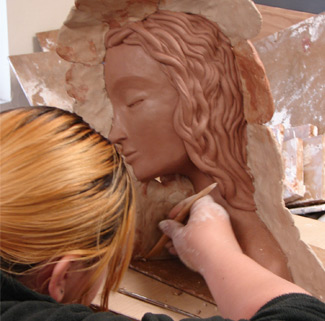Visual Arts Facilities and Programs
Art Appreciation and Art History
Art Appreciation introduces the cultural significance of the visual arts, including media, processes, techniques, traditions, and terminology. This course is approached as an overview, providing key ideas about design, materials and techniques. In Art Appreciation the student will also be introduced to social and historical aspects of art.
Art History provides the knowledge base to understand the visual arts, especially as related to Western culture. The Art History courses are broken into two primary classes, the visual arts from the Ancient through the medieval periods, and the visual arts from the Renaissance through the Modern periods. Both courses examine how art is connected to historical periods, societies and religions, and individuals.
Ceramics
Designed to provide students with a strong background in wheel throwing, hand building and sculpting processes while learning about historical and contemporary ceramics. Conceptual thinking is emphasized in each project to inspire complicated, thoughtful work that is personal and diverse, reflective of the wide range of students.
The ceramics studio features a large common workspace with five worktables and 22 wheels. There are specialized areas for clay making with two pug mills and one extruder, glaze making and a kiln room with three electric kilns and a spray booth. In addition there is an outdoor area containing a large gas kiln, a soda kiln, a raku kiln and a wood fire kiln.
Processes include raku, wood firing, cone 6 electric and gas firings, cone 6 and 10 soda firings as well as low fire glazing options.
Drawing/Painting
The painting and drawing studio provides the student with a good functional space for both drawing and painting classes as well as 2-D design creating, an environment suited for both hands-on work and lecture. The space has twenty tables and twenty easels, a model stand for life drawing and a critique wall.
This space is also a smart room with laptop and digital projector. It also has a secured space for small hand tools with a library of many art books for the students use. Sometimes music will enhance the working atmosphere and for that there is a tape/CD player.
For the oil painting classes the department furnishes both solvent and gesso and the tables work well for the building of canvases.
Our main goals are to furnish the student with solid instruction in various techniques of both drawing and painting. It is our job the give the students the tools of the trade.
Jewelry/Metal Work
Our metalsmithing studio is designed to provide students with all they may need in the fabrication of art pieces in non- ferrous metals. Students are encouraged to make functional and ornamental objects that are based in sound craftsmanship and design. With a strong focus on fabrication over casting, students are well prepared to become well rounded metalsmiths.
The studio work area is well designated and ventilated. The work areas are arranged to accommodate multiple students at a time. There are five atmospheric acetylene torches, one oxy acetylene torch, a vacuum pump, programmable burn out kiln and centrifuge for casting. A sandblaster, roll mill, lapidary polisher, four flex shafts, and an army of stakes and hammers.
Metal processes include soldering, repousse, anticlastic and sinclastic forming, fold forming, hollowware, anodizing, mokume gane, engraving, casting, touch mark making and much more.
Sculpture
Sculpture classes focus on problem solving skills and experience with a variety of traditional approaches to creating work. The instruction in these areas is geared toward enabling the student to achieve their personal vision, to broaden their understanding of sculptural work in terms of approach and meaning, and push their own boundaries.
The sculpture facilities are set up with established sculpture skills in mind. These skills include but are not limited to: Waste-mold, bas-relief latex mold making, in the round latex-mold making, multiple cast slip cast molds, molds for silicone and prosthetic production, light welding for armature and metal sculpture as well as traditional and pneumatic or inline air hammer stone sculpture. Mold making techniques also can be utilized for wax casting for lost wax bronze casting.
Outdoor facilities include compressors for six inline air hammers for carving limestone, marble and granite.









